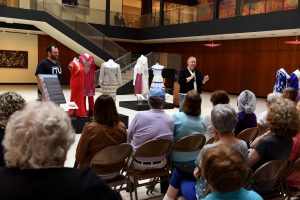Highlighting traditions in ceremonial dress
 This past summer, the Edward W. Root Sculpture Court in the Museum of Art at Munson-Williams-Proctor Arts Institute became a showcase for ceremonial clothing from around the world thanks to the efforts of SUNY Poly’s own Professor of Anthropology, Dr. Kathryn Stam.
This past summer, the Edward W. Root Sculpture Court in the Museum of Art at Munson-Williams-Proctor Arts Institute became a showcase for ceremonial clothing from around the world thanks to the efforts of SUNY Poly’s own Professor of Anthropology, Dr. Kathryn Stam.
Dr. Stam was guest curator for the exhibition “Global Splendor: Traditions in Ceremonial Dress,” where she brought together an assortment of garments that represent important cultural traditions, rituals, or ceremonies from collections in the greater Utica community.
As part of the exhibition, Dr. Stam, along with Midtown Utica Community Center Executive Director Chris Sunderlin led a discussion June 13 to discuss the traditional attire from countries represented in Utica’s culturally diverse population.
Global Splendor highlighted traditional and ceremonial dress from some of the many cultures present in Utica. Historically, the city attracted immigrants from Ireland, Wales, Lebanon, Italy, Poland, and, more recently, from the Dominican Republic and other Caribbean countries. Refugees fleeing war-torn countries began resettling here in 1978 and their numbers now exceed 16,000 with the most recent arrivals from Sudan, Burma, Nepal, and Somalia.
Ceremonial dress places people in space, time, social status, and context. Anthropologists rely on a culture’s textiles, jewelry, and other evidence of bodily adornment because they tell us stories about the group’s tools, availability of materials, skill, and contact with others. A desire to affiliate with or reject other groups is also evident in seemingly simple decisions about dress and the patterns, colors, and motifs lovingly created within them. Clothing reveals cultural norms related to gender, marital status, and how much of our bodies may be shown in public, as well as how clothing can make public spaces feel more private, for example with the use of head scarves. Temporal considerations such as the change of seasons, life cycles, and even the time of day are signified in dress as well, responding to cultural concepts of appropriate roles and public behavior.
Recent Comments
Archives
- September 2018
- August 2018
- May 2018
- April 2018
- March 2018
- February 2018
- January 2018
- December 2017
- November 2017
- October 2017
- September 2017
- May 2017
- April 2017
- March 2017
- February 2017
- January 2017
- December 2016
- November 2016
- October 2016
- September 2016
- August 2016
- May 2016
- April 2016
- March 2016
- February 2016
- January 2016
- December 2015
- November 2015
- October 2015
- September 2015
- August 2015
- May 2015
- April 2015
- March 2015
- February 2015
- January 2015
- December 2014
- November 2014
- October 2014
- September 2014
- August 2014
- May 2014
- April 2014
- March 2014
- February 2014
- January 2014
- December 2013
- November 2013
- October 2013
- September 2013
- August 2013
- June 2013
- May 2013
- April 2013
- March 2013
- February 2013
- January 2013
- December 2012
- November 2012
